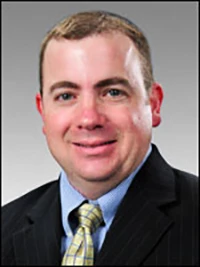
Dr. Lee Miller is an extension turfgrass pathologist at the University of Missouri. GCI chatted with Miller about a busy large patch year and what can be done to control the disease.
How would you characterize 2015 for large patch?
In Missouri and the surrounding region, environmental conditions were perfect for severe large patch outbreaks in 2015. The disease thrives in oversaturated conditions while zoysiagrass is either going into or coming out of dormancy in the fall or spring. In separate two-week spans from mid-May through mid-July, 8 to 12 inches of precipitation fell in all sections of Missouri (i.e. St. Louis, Springfield, Kansas City). Additionally, cool temperatures reigned through early July, resulting in slowed zoysiagrass growth and recovery from large patch infection.
How does it compare to previous years?
I’ve been at the University of Missouri since 2010. 2013 may have had more severe large patch outbreaks, but 2015 had a considerably longer period of spring and summer disease activity. In most years, large patch subsides in early June due to summer temperatures that facilitate aggressive zoysiagrass growth and disease recovery. Cool temperatures extended into early July in 2015, and combined with the frequent rainfall events, provided a sustained infection period for the disease. In untreated areas on the Mizzou Turfgrass Research Farm, symptoms were apparent all summer long on ‘Meyer’ zoysiagrass.
What parts of the country and varieties of turfgrass are experiencing problems with large patch? How do some of the new/emerging warm-season turfgrass varieties handle large patch?
Large patch affects most warm-season turfgrasses, but is most problematic for golf superintendents managing zoysiagrass. Large patch occurs where zoysia goes into dormancy or growth is slowed due to cool temperatures. Because of this, the disease tends to be very severe In the U.S. Transition Zone, particularly in the northern tier of zoysiagrass use (i.e. Missouri, Kansas, Arkansas, Tennessee, Indiana, Illinois, Kentucky). In this upper tier, cold tolerance is vitally important, and the cultivar ‘Meyer’ has been used almost exclusively due to its ability to survive brutal Missouri winters. Colleagues at Kansas State University are developing newer, cold-tolerant zoysia cultivars, but a recent study didn’t find any difference in large patch susceptibility among these freeze tolerant cultivars and ‘Meyer’ (Obasa et al., 2012).
What are some trends in controlling large patch? What should superintendents do in the fall to ensure large patch doesn’t become a future problem at their respective courses?
It is still unclear how many cultural practices impact large patch development. Because of the similarity of the pathogen to brown patch (both share the name Rhizoctonia solani, but are different morphologically and in different anastomosis groups), nitrogen applications during the large patch infection period were theorized to increase disease the same as with brown patch. In a previous study with spring and fall applications of urea (Obasa et al., 2013), no increase in large patch was observed, and in some instances reduced severity of the disease. As noted earlier, large patch thrives in oversaturated conditions, so increasing drainage and avoiding overwatering will help limit the disease. Golf superintendents often need to apply fungicides to achieve acceptable large patch control. Fungicides in the DMI class (e.g. tebuconazole), QoI class (e.g. azoxystrobin) or flutolanil are most often applied. Two, or even three, fungicide applications are commonly made to zoysia fairways during the fall and spring infection periods.
What type of large patch-related research is currently being conducted and how will this benefit superintendents?
Our first area of research involves the impact of fungicide application timing on large patch control. In Missouri, the spring infection period is more conspicuous and impactful than the fall. We investigated the impact of a single fungicide application made in early fall (mid-September), late fall (mid-October), early spring (early April) or mid spring (late April) on the spring large patch epidemic. Spring fungicide applications, even early prior to zoysia greenup, resulted in greater large patch control than single fall applications. This result agrees with research conducted by Patton and Latin at Purdue University. At least in the upper Transition Zone, this research confirms the importance of the spring application, and if two fungicide applications are planned, perhaps one fall and one spring application would result in better control than two fall applications.
We also are continuing to evaluate the impact of nitrogen source and application timing on large patch severity. In collaboration with Kansas State University, concurrent field trials assessed the influence of fall and spring applications of urea, ammonium sulfate, and calcium nitrate versus standard summer fertilization on large patch severity. Although still ongoing, results from these trials are in agreement with previous research that spring nitrogen applications during the infection period do not increase large patch severity and may aid in recovery. Future research will concentrate on the development of an integrated management strategy that combines properly timed fertilizer and fungicide applications to minimize inputs while still achieving acceptable large patch control.
Latest from Golf Course Industry
- From the publisher’s pen: Conscientious of a bigger role
- Bernhard and Company partners with Laguna Golf Phuket
- Terre Blanche showcases environmental stewardship
- VIDEO: Introducing our December issue
- Bernhard and Company introduces Soil Scout
- Nu-Pipe donates to GCSAA Foundation’s Centennial Campaign
- GCSAA enhances golf course BMP tool
- Melrose leadership programs sending 18 to 2026 GCSAA Conference and Trade Show





